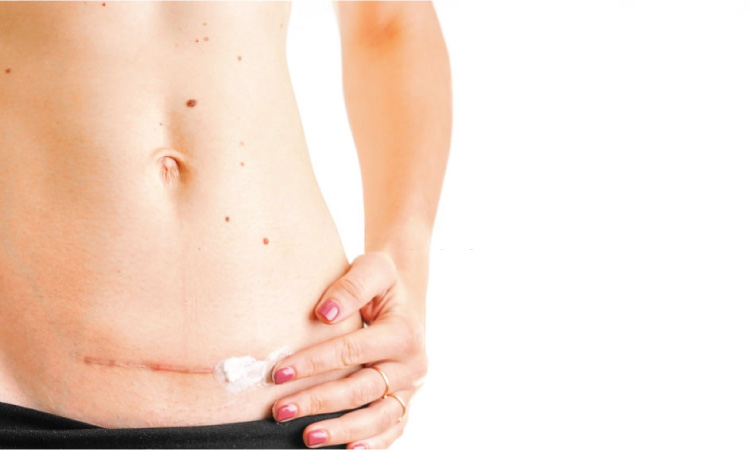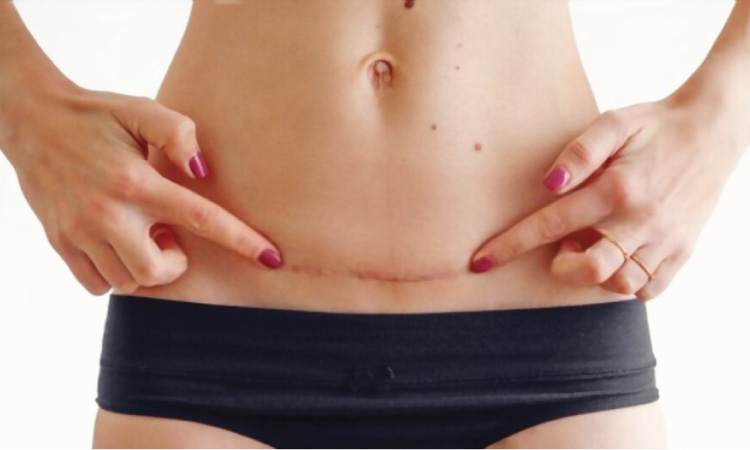Have you recently undergone a C-section? Or are you a pregnant woman awaiting a scheduled C- section? In either case, you’re on the right page. This article discusses 11 effective home remedies for C-section recovery.
Consider what would happen if you were given a small baby to care for instead of someone caring for you after major abdominal surgery. This occurs with each C-section. You will not have that luxury following a C-section, as opposed to other surgeries where you can afford to give yourself time to heal.
Do you want to know how to heal quickly after a C-section? Just following some simple steps will make your recovery healthy and fast.
How Can I Get My C-section To Heal Faster?
C-section is major abdominal surgery, and the scars from the procedure are typically 2 to 3 inches long. It is so deep that it cuts through all layers of skin, muscles, and the womb. Since the scar is deep, the womb and the overlying muscle layers require around six months to heal completely. Thus, certain do’s and don’ts after a C-section delivery must be adhered religiously for a faster recovery.
This does not, however, imply that you must endure all of the pain and discomfort associated with the healing process. Some home remedies can help manage pain and speed up the recovery process.
11 Home Remedies For C-section Recovery
Our panel gynaecologist Dr Ankita Patel Tayal says that mothers who have had a caesarean section are indeed more likely to face other health challenges, such as pain, an infected scar, and constipation. They also need to watch out for any signs of infection after a C-section delivery particularly. As a result, proper nutrition, proper C-section incision care at home, and medication are unavoidable parts of C-section recovery.
The 11 effective home remedies for a faster C-section recovery are listed below.
1. C-section incision care
When it comes to C-section recovery, the most important factor to consider is incision care. One of your concerns should be “Is my C-section healing inside”. Proper incision care will promote scar healing. For this:
- Always keep the incision site clean and dry
- Apply the right ointment prescribed by your doctor
- Keep an eye out for signs of infection, such as fever and stinky discharge from the incision site
- Consult your doctor right away if you notice redness, swelling, or severe pain in or around the incision area. Early detection makes the treatment easier and effective
2. Tips to manage C-section pain

Pain is one of the anticipated outcomes of a C-section. You can’t surpass it. Being in constant pain may delay the recovery process. However, there are a few steps that can help to manage the pain of a C-section:
- Take pain relievers as directed by your doctor
- Never use over-the-counter pain relievers without the permission of your doctor
- Always take the medication prescribed by your doctor as directed. Medicines are prescribed by doctors for a reason. Never, ever skip it. Even if you think you’re fine, finish the course
- Coughing, sneezing, and even laughing will put extra pressure on the incision area, causing sharp pains. When you laugh, sneeze, or cough, press a pillow against your incision site. An abdominal binder may also be beneficial. However, only use it as directed by your doctor
- Hot compresses are another option. You can use a hot water bottle or a heating pad as a hot compress. You can even take a warm herbal bath—just make sure the water isn’t too hot. Heat relaxes your muscles and increases blood flow to the affected area. And, as the nerves start passing the sensation of warmth to your brain, the pain signal will be muffled
- Take essential measures to deal with tailbone pain after a C-section delivery
3. Take measures to prevent constipation
Constipation during pregnancy is very common but constipation is also one of the most common post-C-section complaints. This unpleasant problem is caused by a combination of immobility and intake of pain relievers & antibiotics after this major abdominal surgery.
Constipation after C-section puts additional pressure on stitches that will aggravate the pain and discomforts. Fortunately, getting plenty of fiber and fluids can help things move along.
Proper hydration after a C-section is critical in preventing constipation. Drink 8 glasses of water per day and eat plenty of fruits and vegetables, whole grains, nuts, seeds, and legumes. Choose foods like okra, oats, chia seeds, and flax seeds. Their slimy texture will soften your stool and make it easier to pass.
4. Take steps to restore gut health
Following a C-section, you will be on a strong antibiotic course for a period, which is necessary to prevent infection and promote wound healing. However, antibiotics can kill the beneficial bacteria in your gut, which is essential for gut health.
Simple diet changes after a C-section will help to restore the gut health of the mother. Intake of a high-quality probiotic can help restore the balance of good bacteria in the gut.
A daily intake of probiotics will also help the body to enhance nutrition absorption from other foods. To begin, incorporate probiotic-rich foods into your diets, such as plain unflavoured yogurt and kombucha tea.
5. Focus on the right nutrition after C-section
Your body will be in recovery mode following a C-section. Good nutrition is equally important in the months following delivery as it was during pregnancy. To re-establish health, your body requires a variety of foods and nutrients.
Furthermore, now that you are breastfeeding, eating a variety of healthy foods will help to improve the quality and quantity of breast milk. Make sure that your post C-section diet:
- Contains protein-rich foods: Protein aids in the healing and repair of body tissues, as well as the growth of muscle
- Include foods that are rich in minerals and phytonutrients
- Is enriched with Iron and vitamin C-rich foods: Iron is essential for blood loss, and vitamin C can help fight infection
- Is not including any foods that should be should be completely avoided after Caesarean delivery
6. Never stop the intake of prenatal vitamin
After a C-section, various factors can interfere with the way you eat. If you fail to satisfy food quantities and quality after C-section, you will probably not meet all of your nutrient needs.
This affects the recovery speed of the C-section. That is why it is said that your prenatal nutrient supplies should not stop immediately after delivery.
Dr Ankita Patel Tayal, MD obgyn, explains that prenatal can help fill in your nutrient deficiencies from the food. Prenatal contains iron, which you undoubtedly need to rebuild your lost blood cells following a C-section. Similarly, zinc and vitamin C in prenatal is very important to correct wound healings.
7. Massaging C-section site may help
You can start massaging your scar once it is closed and healed. This doesn’t seem to be an enjoyable experience, but massaging your C-section scar can help prevent potential problems in the future, such as pain during sex, lower back pain, etc.
Here is how massaging helps in C-section recovery:
- Scar tissue shows a tendency to form in all possible directions. It even attaches to organs, including your ovaries and bladder. Massaging the scar tissue aids in the healing and formation of scar tissue in the proper direction
- Massaging also Aids in preventing scar tissue from causing tightness or pulling sensations
Related Reading: 40 Days After Delivery – 8 Precautions And 6 Ways To Spend Them
How to massage the scar tissue?

Once your scar has healed completely (which happens around 6-8 weeks after the C-section), you can begin carefully massaging it with your fingertips for about five minutes every day. Massage your scar by first stretching the skin around it and then massaging the scar itself. Circularly move your fingers over the scar and the surrounding area. Never press or exert pressure.
8. Focus on the right nursing position
There are sometips to take care of a baby after a C-section. According to the C-section guideline, you shouldn’t lift anything heavier than your baby after the procedure. This means you can lift your baby without fear. However, until the scars heal completely, you can put a pillow over your belly to ease the baby’s weight.
Likewise, always focus on the right nursing position.
It may be difficult to find a comfortable position to nurse your baby due to the location of the surgery. However, the following nursing positions will help:
- Football hold: Hold your baby’s neck in your palm and place their back on your forearm. Tuck their legs and feet under your arm, and then lift your baby to your breast
- Side-lying holds: As you lie down facing your baby, gently press your nipple against their lips with your hand. You may want to place a pillow behind them back to prevent them from rolling
Both these postures will not put any pressure on your C-section scar.
Related Reading: 12 Important Tips For After Delivery Care
9. Resume physical activities after delivery gradually
The benefits of resuming physical activity following a C-section include improving blood circulation and hastening the healing process. Overexertion, on the other hand, is not recommended as it slows down the healing process.
Carrying weights or returning to a strenuous exercise routine too soon after the C-section will stretch the wound. This increases the risk of rupture of the wound and thereby backfires the healing process.
Unhealed wounds can cause permanent impairment to the abdominal muscles. Besides, it may also have an impact on the general health and quality of life of the mother.
It is a good idea to start physical activities by walking. Walking helps increase blood circulation and relaxes the body and mind. Diaphragmatic breathing (slow and deep breath), too, assists in internal organ massage and muscle relaxation.
You can do this breathing technique for 5–10 minutes at a time. You can repeat this three to four times per day. Combined with walking, diaphragmatic breathing helps to regain stamina after C-section.
10. Incorporate iron-rich food/supplement in the diet
Caesarean delivery often results in blood loss. This could end up in post-partum anemia. You can prevent postpartum anemia by increasing your iron levels.
Anemia after pregnancy usually results in excessive fatigue, weakness, and irritability. A decrease in the quality and quantity of breast milk is also noticed among new mothers with anemia.
Related Reading: 21 Breastfeeding Tips For First Time Mothers
If you experience any of the above-mentioned signs, discuss with your doctor for iron supplements. At home, incorporate more iron-rich foods into your diet such as green leafy veggies and dried fruits are rich in iron content.
11. Take plenty of rest

Resting is easier said than done when you have a child to look after. But it’s necessary. Rest, like after any surgery, allows your body to repair itself and keeps your immune system strong after a C-section.
Remember that rest does not always imply sleeping or napping. What calms and soothes you? Reading? Listening to music? Do that. That is the definition of rest.
You’ve probably heard a piece of advice “take rest whenever your baby rests.” This is the practical way to take a rest. When your baby is sleeping, try to sleep as well.
You can seek help from your friends and family with diaper changes and running errands so that you can rest whenever possible. Even though not able to get a continuous rest, a few minutes of rest every now and then can also be beneficial.
Conclusion
These suggestions will help address the most common post C- section concerns and will promote recovery as soon as possible and naturally. However, please consult your doctor if you have any concerns or persistent concerns.
FAQs
You may have assumed that your bouts of nausea would end with delivery, but nausea after a C-section is extremely common.
Constipation, abdominal bloating, surgery, and hormonal changes are all to blame. Inhaling the pleasant aroma of essential oils is a great way to settle a queasy stomach.
Traditional chicken broth can be extremely beneficial in the recovery process after cesarean delivery. Bone broth is high in amino acids like proline and glycine, which are important for collagen production and skin healing.
Broth also contains gelatin, which is good for wound healing and skin health. Consume nutritious and mineral-rich broth at least once or twice a day. Chicken broth can also help with the digestive discomforts and constipation that often accompany cesarean delivery.


